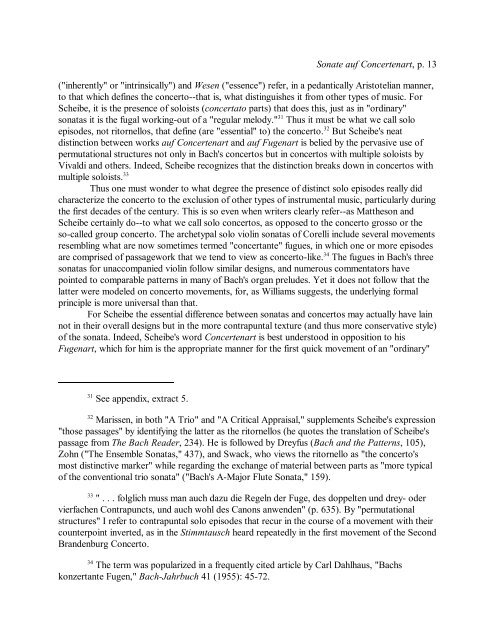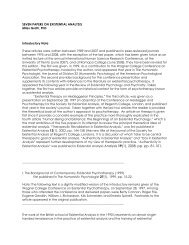The Sonate auf Concertenart: A Postmodern Invention? David ...
The Sonate auf Concertenart: A Postmodern Invention? David ...
The Sonate auf Concertenart: A Postmodern Invention? David ...
You also want an ePaper? Increase the reach of your titles
YUMPU automatically turns print PDFs into web optimized ePapers that Google loves.
31<br />
See appendix, extract 5.<br />
<strong>Sonate</strong> <strong>auf</strong> <strong>Concertenart</strong>, p. 13<br />
("inherently" or "intrinsically") and Wesen ("essence") refer, in a pedantically Aristotelian manner,<br />
to that which defines the concerto--that is, what distinguishes it from other types of music. For<br />
Scheibe, it is the presence of soloists (concertato parts) that does this, just as in "ordinary"<br />
31<br />
sonatas it is the fugal working-out of a "regular melody." Thus it must be what we call solo<br />
32<br />
episodes, not ritornellos, that define (are "essential" to) the concerto. But Scheibe's neat<br />
distinction between works <strong>auf</strong> <strong>Concertenart</strong> and <strong>auf</strong> Fugenart is belied by the pervasive use of<br />
permutational structures not only in Bach's concertos but in concertos with multiple soloists by<br />
Vivaldi and others. Indeed, Scheibe recognizes that the distinction breaks down in concertos with<br />
multiple soloists. 33<br />
Thus one must wonder to what degree the presence of distinct solo episodes really did<br />
characterize the concerto to the exclusion of other types of instrumental music, particularly during<br />
the first decades of the century. This is so even when writers clearly refer--as Mattheson and<br />
Scheibe certainly do--to what we call solo concertos, as opposed to the concerto grosso or the<br />
so-called group concerto. <strong>The</strong> archetypal solo violin sonatas of Corelli include several movements<br />
resembling what are now sometimes termed "concertante" fugues, in which one or more episodes<br />
34<br />
are comprised of passagework that we tend to view as concerto-like. <strong>The</strong> fugues in Bach's three<br />
sonatas for unaccompanied violin follow similar designs, and numerous commentators have<br />
pointed to comparable patterns in many of Bach's organ preludes. Yet it does not follow that the<br />
latter were modeled on concerto movements, for, as Williams suggests, the underlying formal<br />
principle is more universal than that.<br />
For Scheibe the essential difference between sonatas and concertos may actually have lain<br />
not in their overall designs but in the more contrapuntal texture (and thus more conservative style)<br />
of the sonata. Indeed, Scheibe's word <strong>Concertenart</strong> is best understood in opposition to his<br />
Fugenart, which for him is the appropriate manner for the first quick movement of an "ordinary"<br />
32<br />
Marissen, in both "A Trio" and "A Critical Appraisal," supplements Scheibe's expression<br />
"those passages" by identifying the latter as the ritornellos (he quotes the translation of Scheibe's<br />
passage from <strong>The</strong> Bach Reader, 234). He is followed by Dreyfus (Bach and the Patterns, 105),<br />
Zohn ("<strong>The</strong> Ensemble Sonatas," 437), and Swack, who views the ritornello as "the concerto's<br />
most distinctive marker" while regarding the exchange of material between parts as "more typical<br />
of the conventional trio sonata" ("Bach's A-Major Flute Sonata," 159).<br />
33<br />
" . . . folglich muss man auch dazu die Regeln der Fuge, des doppelten und drey- oder<br />
vierfachen Contrapuncts, und auch wohl des Canons anwenden" (p. 635). By "permutational<br />
structures" I refer to contrapuntal solo episodes that recur in the course of a movement with their<br />
counterpoint inverted, as in the Stimmtausch heard repeatedly in the first movement of the Second<br />
Brandenburg Concerto.<br />
34 <strong>The</strong> term was popularized in a frequently cited article by Carl Dahlhaus, "Bachs<br />
konzertante Fugen," Bach-Jahrbuch 41 (1955): 45-72.















